IT Report: Cloud Computing, Deployment Models and Industry Analysis
VerifiedAdded on 2022/08/16
|13
|2750
|11
Report
AI Summary
This report provides a comprehensive overview of cloud computing, focusing on its characteristics, development trends, and the core service models: IaaS, PaaS, and SaaS. It explores the advantages of cloud computing, such as self-service provisioning, elasticity, and migration flexibility. The report delves into the distinctions between SaaS, PaaS, and IaaS, highlighting their respective roles and benefits. Furthermore, it examines the deployment of these cloud paradigms across various business sectors, including manufacturing, healthcare, and education, illustrating how cloud computing is transforming these industries. The report also touches on the future trends in cloud computing, addressing the increasing importance of cloud adoption and its potential impact on businesses globally. The report concludes by emphasizing the opportunities within the IT market and the increasing adoption of cloud computing across various sectors.
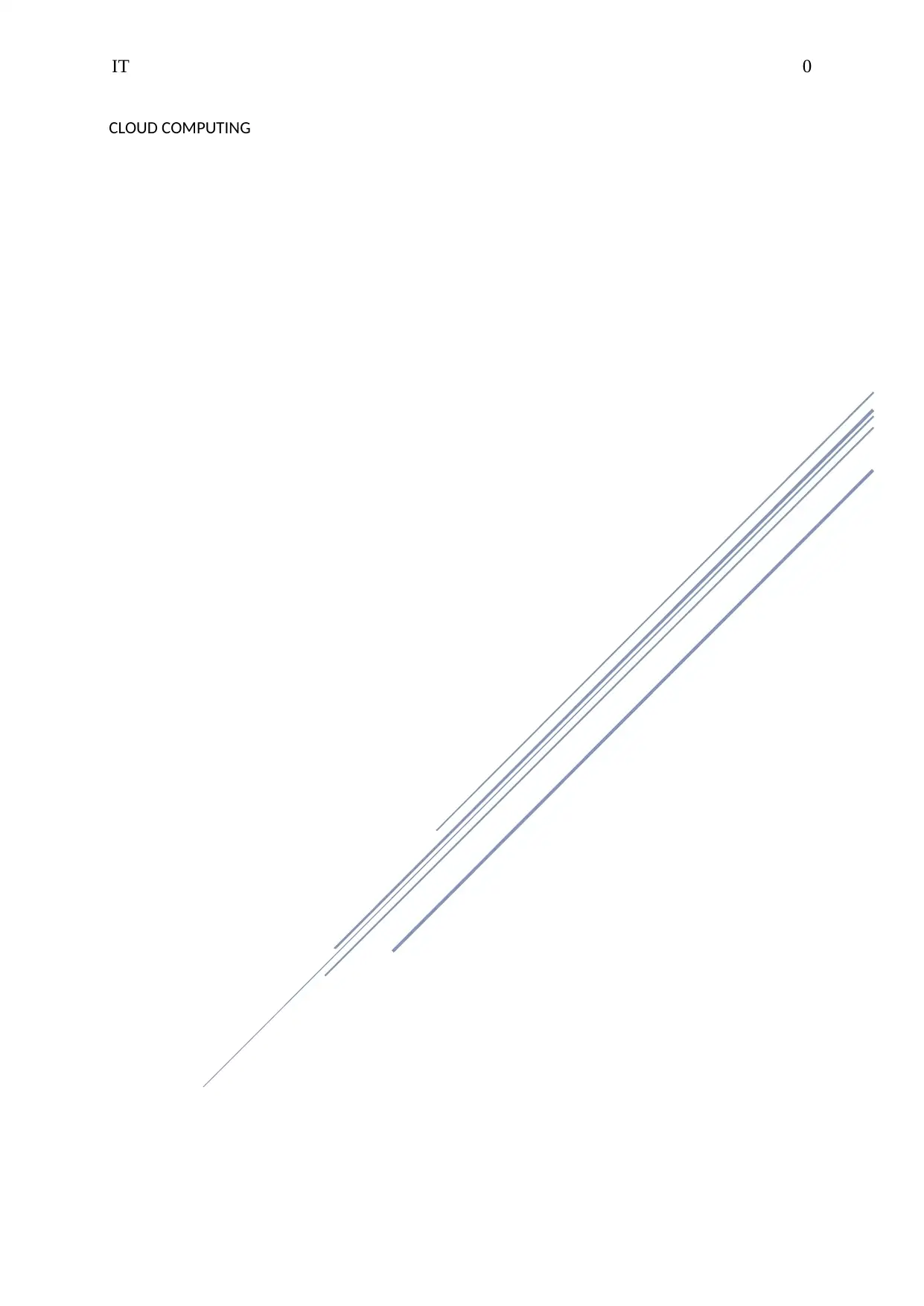
IT 0
CLOUD COMPUTING
CLOUD COMPUTING
Paraphrase This Document
Need a fresh take? Get an instant paraphrase of this document with our AI Paraphraser
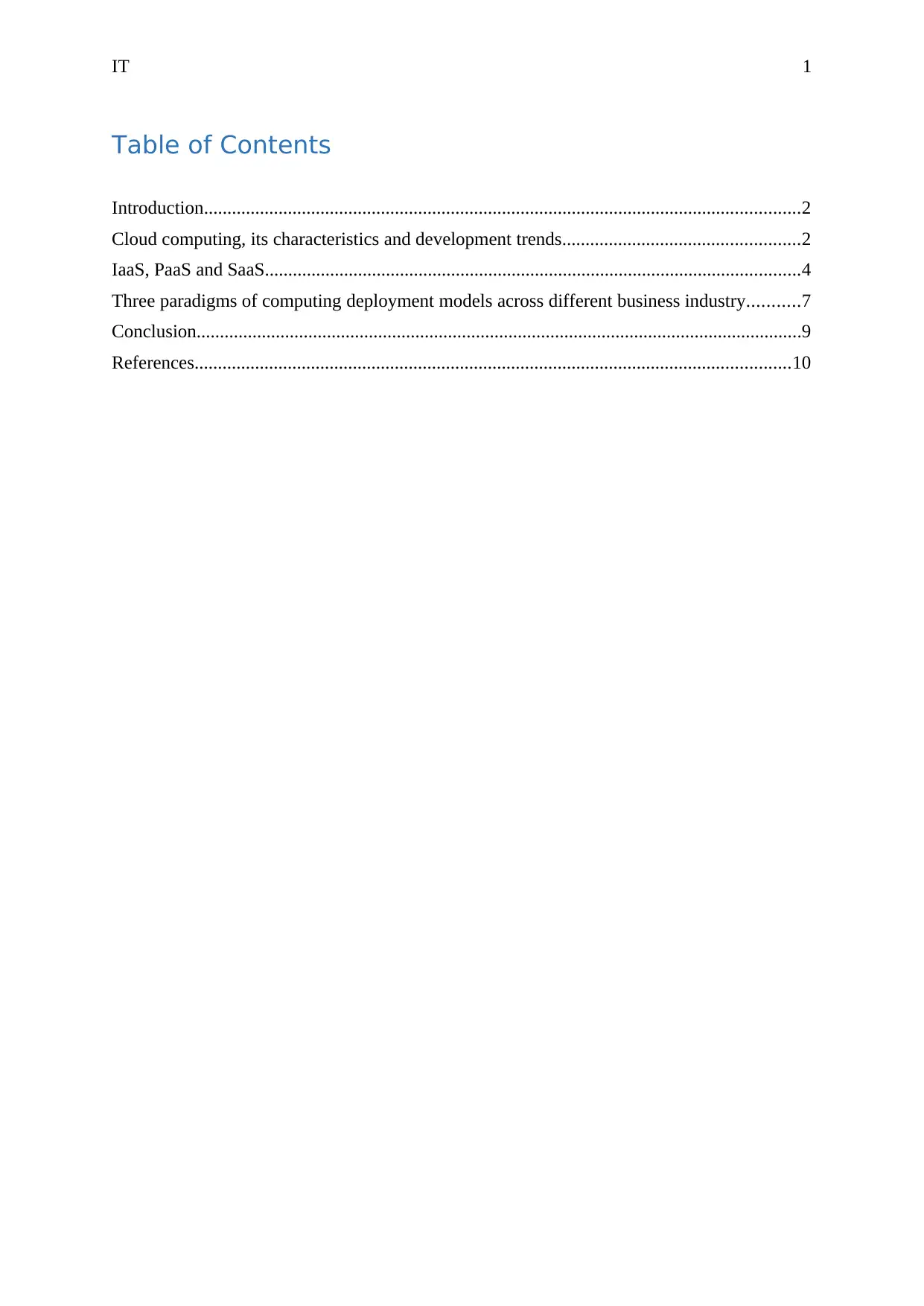
IT 1
Table of Contents
Introduction................................................................................................................................2
Cloud computing, its characteristics and development trends...................................................2
IaaS, PaaS and SaaS...................................................................................................................4
Three paradigms of computing deployment models across different business industry...........7
Conclusion..................................................................................................................................9
References................................................................................................................................10
Table of Contents
Introduction................................................................................................................................2
Cloud computing, its characteristics and development trends...................................................2
IaaS, PaaS and SaaS...................................................................................................................4
Three paradigms of computing deployment models across different business industry...........7
Conclusion..................................................................................................................................9
References................................................................................................................................10
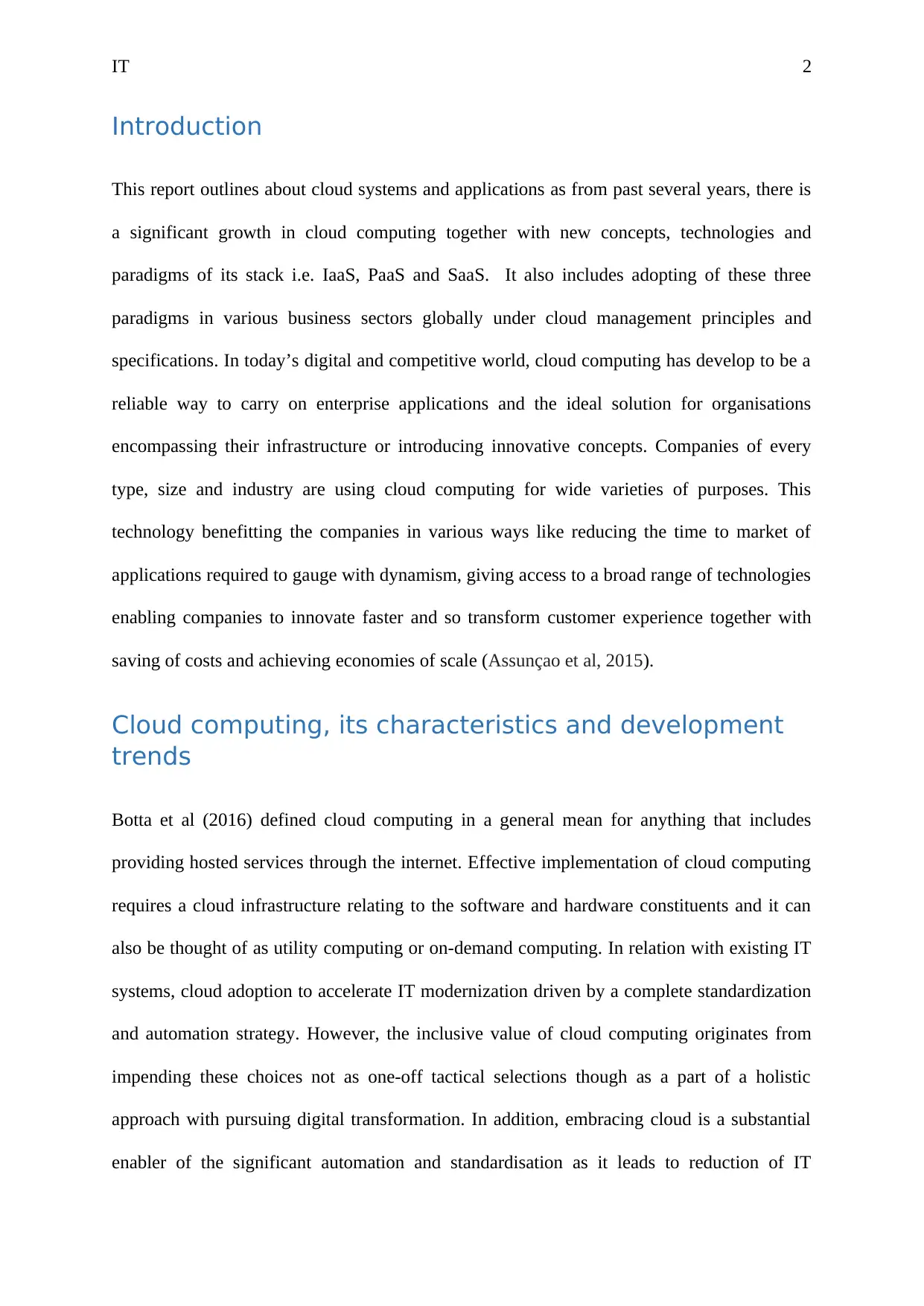
IT 2
Introduction
This report outlines about cloud systems and applications as from past several years, there is
a significant growth in cloud computing together with new concepts, technologies and
paradigms of its stack i.e. IaaS, PaaS and SaaS. It also includes adopting of these three
paradigms in various business sectors globally under cloud management principles and
specifications. In today’s digital and competitive world, cloud computing has develop to be a
reliable way to carry on enterprise applications and the ideal solution for organisations
encompassing their infrastructure or introducing innovative concepts. Companies of every
type, size and industry are using cloud computing for wide varieties of purposes. This
technology benefitting the companies in various ways like reducing the time to market of
applications required to gauge with dynamism, giving access to a broad range of technologies
enabling companies to innovate faster and so transform customer experience together with
saving of costs and achieving economies of scale (Assunçao et al, 2015).
Cloud computing, its characteristics and development
trends
Botta et al (2016) defined cloud computing in a general mean for anything that includes
providing hosted services through the internet. Effective implementation of cloud computing
requires a cloud infrastructure relating to the software and hardware constituents and it can
also be thought of as utility computing or on-demand computing. In relation with existing IT
systems, cloud adoption to accelerate IT modernization driven by a complete standardization
and automation strategy. However, the inclusive value of cloud computing originates from
impending these choices not as one-off tactical selections though as a part of a holistic
approach with pursuing digital transformation. In addition, embracing cloud is a substantial
enabler of the significant automation and standardisation as it leads to reduction of IT
Introduction
This report outlines about cloud systems and applications as from past several years, there is
a significant growth in cloud computing together with new concepts, technologies and
paradigms of its stack i.e. IaaS, PaaS and SaaS. It also includes adopting of these three
paradigms in various business sectors globally under cloud management principles and
specifications. In today’s digital and competitive world, cloud computing has develop to be a
reliable way to carry on enterprise applications and the ideal solution for organisations
encompassing their infrastructure or introducing innovative concepts. Companies of every
type, size and industry are using cloud computing for wide varieties of purposes. This
technology benefitting the companies in various ways like reducing the time to market of
applications required to gauge with dynamism, giving access to a broad range of technologies
enabling companies to innovate faster and so transform customer experience together with
saving of costs and achieving economies of scale (Assunçao et al, 2015).
Cloud computing, its characteristics and development
trends
Botta et al (2016) defined cloud computing in a general mean for anything that includes
providing hosted services through the internet. Effective implementation of cloud computing
requires a cloud infrastructure relating to the software and hardware constituents and it can
also be thought of as utility computing or on-demand computing. In relation with existing IT
systems, cloud adoption to accelerate IT modernization driven by a complete standardization
and automation strategy. However, the inclusive value of cloud computing originates from
impending these choices not as one-off tactical selections though as a part of a holistic
approach with pursuing digital transformation. In addition, embracing cloud is a substantial
enabler of the significant automation and standardisation as it leads to reduction of IT
⊘ This is a preview!⊘
Do you want full access?
Subscribe today to unlock all pages.

Trusted by 1+ million students worldwide
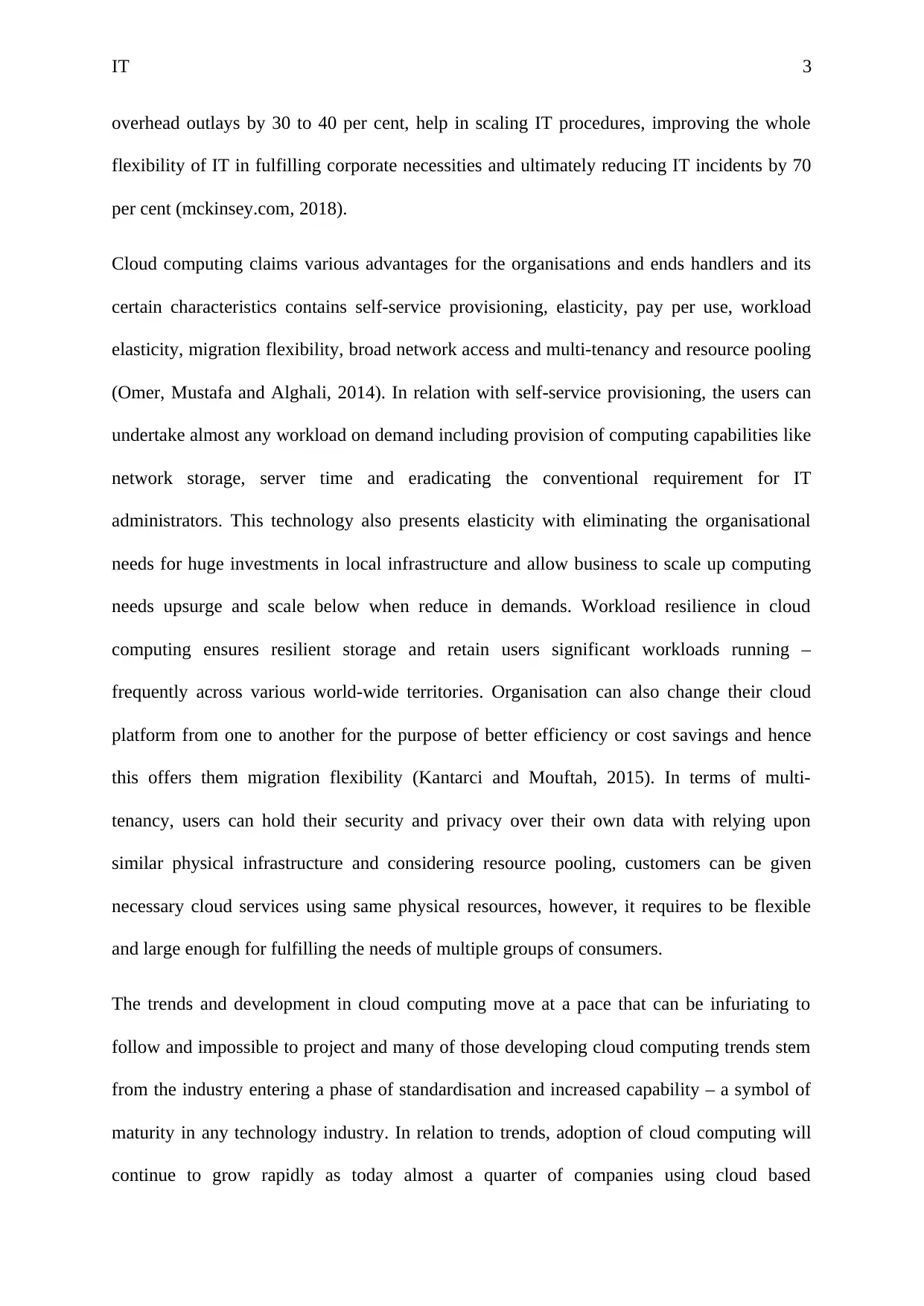
IT 3
overhead outlays by 30 to 40 per cent, help in scaling IT procedures, improving the whole
flexibility of IT in fulfilling corporate necessities and ultimately reducing IT incidents by 70
per cent (mckinsey.com, 2018).
Cloud computing claims various advantages for the organisations and ends handlers and its
certain characteristics contains self-service provisioning, elasticity, pay per use, workload
elasticity, migration flexibility, broad network access and multi-tenancy and resource pooling
(Omer, Mustafa and Alghali, 2014). In relation with self-service provisioning, the users can
undertake almost any workload on demand including provision of computing capabilities like
network storage, server time and eradicating the conventional requirement for IT
administrators. This technology also presents elasticity with eliminating the organisational
needs for huge investments in local infrastructure and allow business to scale up computing
needs upsurge and scale below when reduce in demands. Workload resilience in cloud
computing ensures resilient storage and retain users significant workloads running –
frequently across various world-wide territories. Organisation can also change their cloud
platform from one to another for the purpose of better efficiency or cost savings and hence
this offers them migration flexibility (Kantarci and Mouftah, 2015). In terms of multi-
tenancy, users can hold their security and privacy over their own data with relying upon
similar physical infrastructure and considering resource pooling, customers can be given
necessary cloud services using same physical resources, however, it requires to be flexible
and large enough for fulfilling the needs of multiple groups of consumers.
The trends and development in cloud computing move at a pace that can be infuriating to
follow and impossible to project and many of those developing cloud computing trends stem
from the industry entering a phase of standardisation and increased capability – a symbol of
maturity in any technology industry. In relation to trends, adoption of cloud computing will
continue to grow rapidly as today almost a quarter of companies using cloud based
overhead outlays by 30 to 40 per cent, help in scaling IT procedures, improving the whole
flexibility of IT in fulfilling corporate necessities and ultimately reducing IT incidents by 70
per cent (mckinsey.com, 2018).
Cloud computing claims various advantages for the organisations and ends handlers and its
certain characteristics contains self-service provisioning, elasticity, pay per use, workload
elasticity, migration flexibility, broad network access and multi-tenancy and resource pooling
(Omer, Mustafa and Alghali, 2014). In relation with self-service provisioning, the users can
undertake almost any workload on demand including provision of computing capabilities like
network storage, server time and eradicating the conventional requirement for IT
administrators. This technology also presents elasticity with eliminating the organisational
needs for huge investments in local infrastructure and allow business to scale up computing
needs upsurge and scale below when reduce in demands. Workload resilience in cloud
computing ensures resilient storage and retain users significant workloads running –
frequently across various world-wide territories. Organisation can also change their cloud
platform from one to another for the purpose of better efficiency or cost savings and hence
this offers them migration flexibility (Kantarci and Mouftah, 2015). In terms of multi-
tenancy, users can hold their security and privacy over their own data with relying upon
similar physical infrastructure and considering resource pooling, customers can be given
necessary cloud services using same physical resources, however, it requires to be flexible
and large enough for fulfilling the needs of multiple groups of consumers.
The trends and development in cloud computing move at a pace that can be infuriating to
follow and impossible to project and many of those developing cloud computing trends stem
from the industry entering a phase of standardisation and increased capability – a symbol of
maturity in any technology industry. In relation to trends, adoption of cloud computing will
continue to grow rapidly as today almost a quarter of companies using cloud based
Paraphrase This Document
Need a fresh take? Get an instant paraphrase of this document with our AI Paraphraser
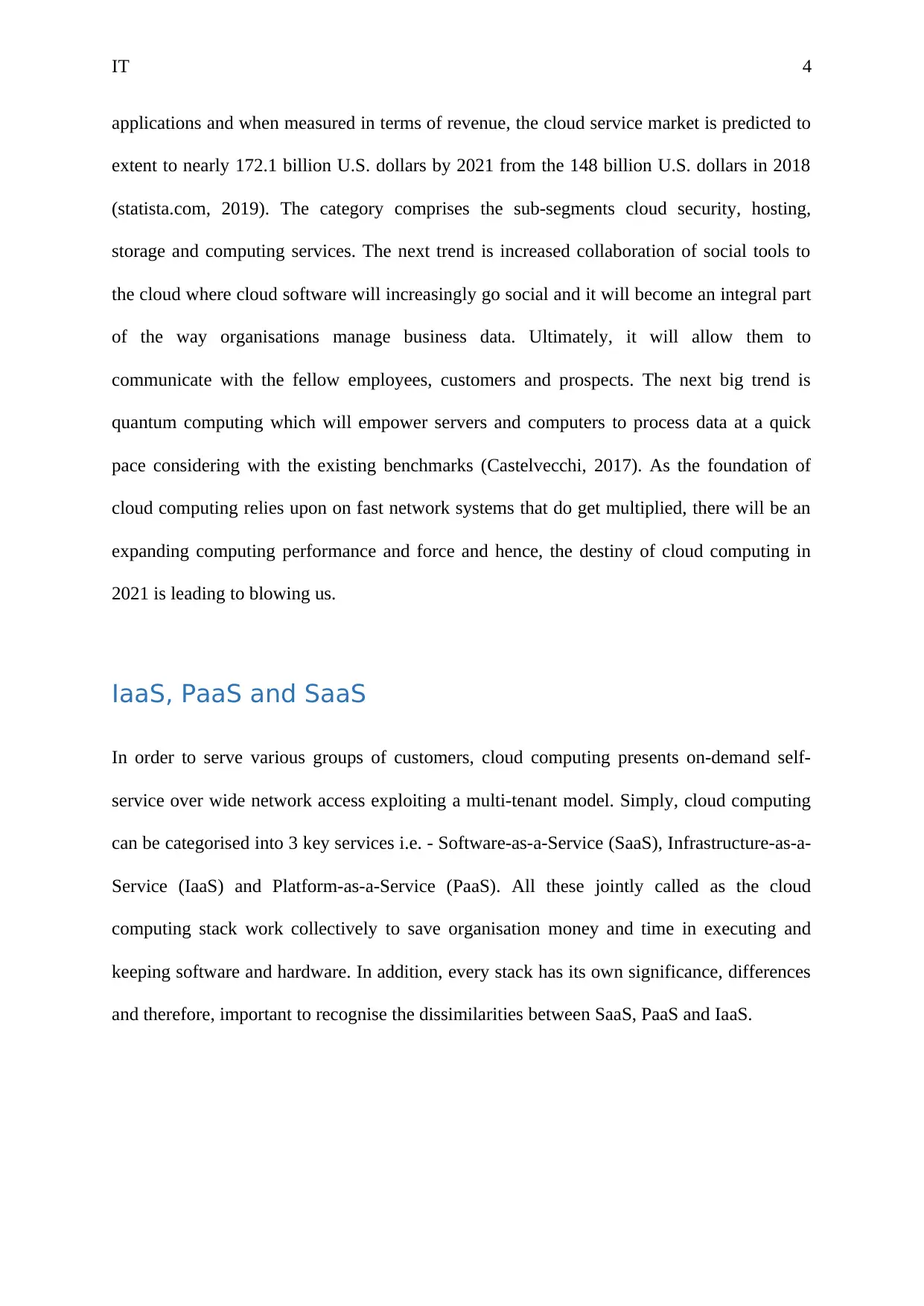
IT 4
applications and when measured in terms of revenue, the cloud service market is predicted to
extent to nearly 172.1 billion U.S. dollars by 2021 from the 148 billion U.S. dollars in 2018
(statista.com, 2019). The category comprises the sub-segments cloud security, hosting,
storage and computing services. The next trend is increased collaboration of social tools to
the cloud where cloud software will increasingly go social and it will become an integral part
of the way organisations manage business data. Ultimately, it will allow them to
communicate with the fellow employees, customers and prospects. The next big trend is
quantum computing which will empower servers and computers to process data at a quick
pace considering with the existing benchmarks (Castelvecchi, 2017). As the foundation of
cloud computing relies upon on fast network systems that do get multiplied, there will be an
expanding computing performance and force and hence, the destiny of cloud computing in
2021 is leading to blowing us.
IaaS, PaaS and SaaS
In order to serve various groups of customers, cloud computing presents on-demand self-
service over wide network access exploiting a multi-tenant model. Simply, cloud computing
can be categorised into 3 key services i.e. - Software-as-a-Service (SaaS), Infrastructure-as-a-
Service (IaaS) and Platform-as-a-Service (PaaS). All these jointly called as the cloud
computing stack work collectively to save organisation money and time in executing and
keeping software and hardware. In addition, every stack has its own significance, differences
and therefore, important to recognise the dissimilarities between SaaS, PaaS and IaaS.
applications and when measured in terms of revenue, the cloud service market is predicted to
extent to nearly 172.1 billion U.S. dollars by 2021 from the 148 billion U.S. dollars in 2018
(statista.com, 2019). The category comprises the sub-segments cloud security, hosting,
storage and computing services. The next trend is increased collaboration of social tools to
the cloud where cloud software will increasingly go social and it will become an integral part
of the way organisations manage business data. Ultimately, it will allow them to
communicate with the fellow employees, customers and prospects. The next big trend is
quantum computing which will empower servers and computers to process data at a quick
pace considering with the existing benchmarks (Castelvecchi, 2017). As the foundation of
cloud computing relies upon on fast network systems that do get multiplied, there will be an
expanding computing performance and force and hence, the destiny of cloud computing in
2021 is leading to blowing us.
IaaS, PaaS and SaaS
In order to serve various groups of customers, cloud computing presents on-demand self-
service over wide network access exploiting a multi-tenant model. Simply, cloud computing
can be categorised into 3 key services i.e. - Software-as-a-Service (SaaS), Infrastructure-as-a-
Service (IaaS) and Platform-as-a-Service (PaaS). All these jointly called as the cloud
computing stack work collectively to save organisation money and time in executing and
keeping software and hardware. In addition, every stack has its own significance, differences
and therefore, important to recognise the dissimilarities between SaaS, PaaS and IaaS.
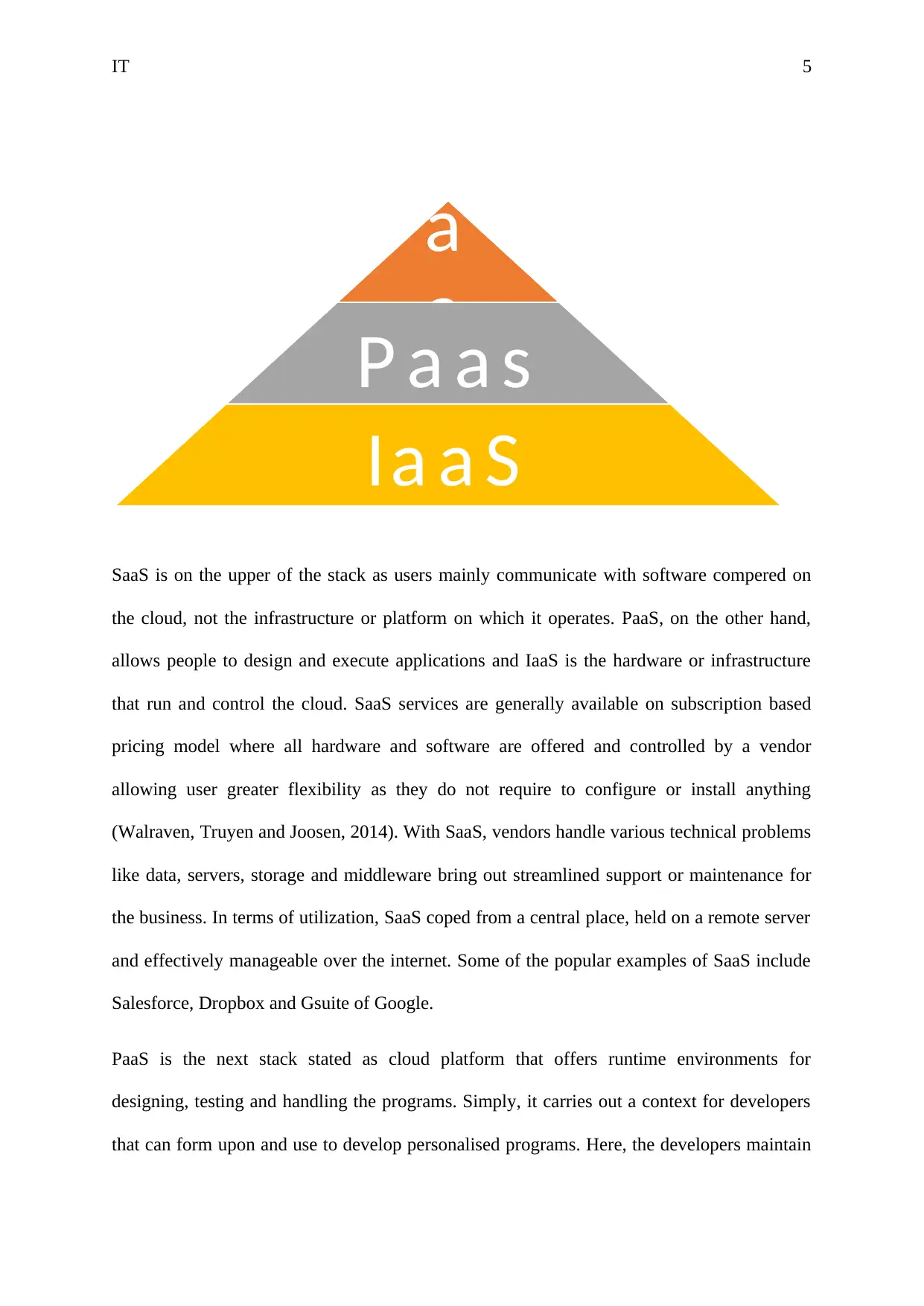
IT 5
SaaS is on the upper of the stack as users mainly communicate with software compered on
the cloud, not the infrastructure or platform on which it operates. PaaS, on the other hand,
allows people to design and execute applications and IaaS is the hardware or infrastructure
that run and control the cloud. SaaS services are generally available on subscription based
pricing model where all hardware and software are offered and controlled by a vendor
allowing user greater flexibility as they do not require to configure or install anything
(Walraven, Truyen and Joosen, 2014). With SaaS, vendors handle various technical problems
like data, servers, storage and middleware bring out streamlined support or maintenance for
the business. In terms of utilization, SaaS coped from a central place, held on a remote server
and effectively manageable over the internet. Some of the popular examples of SaaS include
Salesforce, Dropbox and Gsuite of Google.
PaaS is the next stack stated as cloud platform that offers runtime environments for
designing, testing and handling the programs. Simply, it carries out a context for developers
that can form upon and use to develop personalised programs. Here, the developers maintain
S
a
a
SP a a s
Ia a S
SaaS is on the upper of the stack as users mainly communicate with software compered on
the cloud, not the infrastructure or platform on which it operates. PaaS, on the other hand,
allows people to design and execute applications and IaaS is the hardware or infrastructure
that run and control the cloud. SaaS services are generally available on subscription based
pricing model where all hardware and software are offered and controlled by a vendor
allowing user greater flexibility as they do not require to configure or install anything
(Walraven, Truyen and Joosen, 2014). With SaaS, vendors handle various technical problems
like data, servers, storage and middleware bring out streamlined support or maintenance for
the business. In terms of utilization, SaaS coped from a central place, held on a remote server
and effectively manageable over the internet. Some of the popular examples of SaaS include
Salesforce, Dropbox and Gsuite of Google.
PaaS is the next stack stated as cloud platform that offers runtime environments for
designing, testing and handling the programs. Simply, it carries out a context for developers
that can form upon and use to develop personalised programs. Here, the developers maintain
S
a
a
SP a a s
Ia a S
⊘ This is a preview!⊘
Do you want full access?
Subscribe today to unlock all pages.

Trusted by 1+ million students worldwide
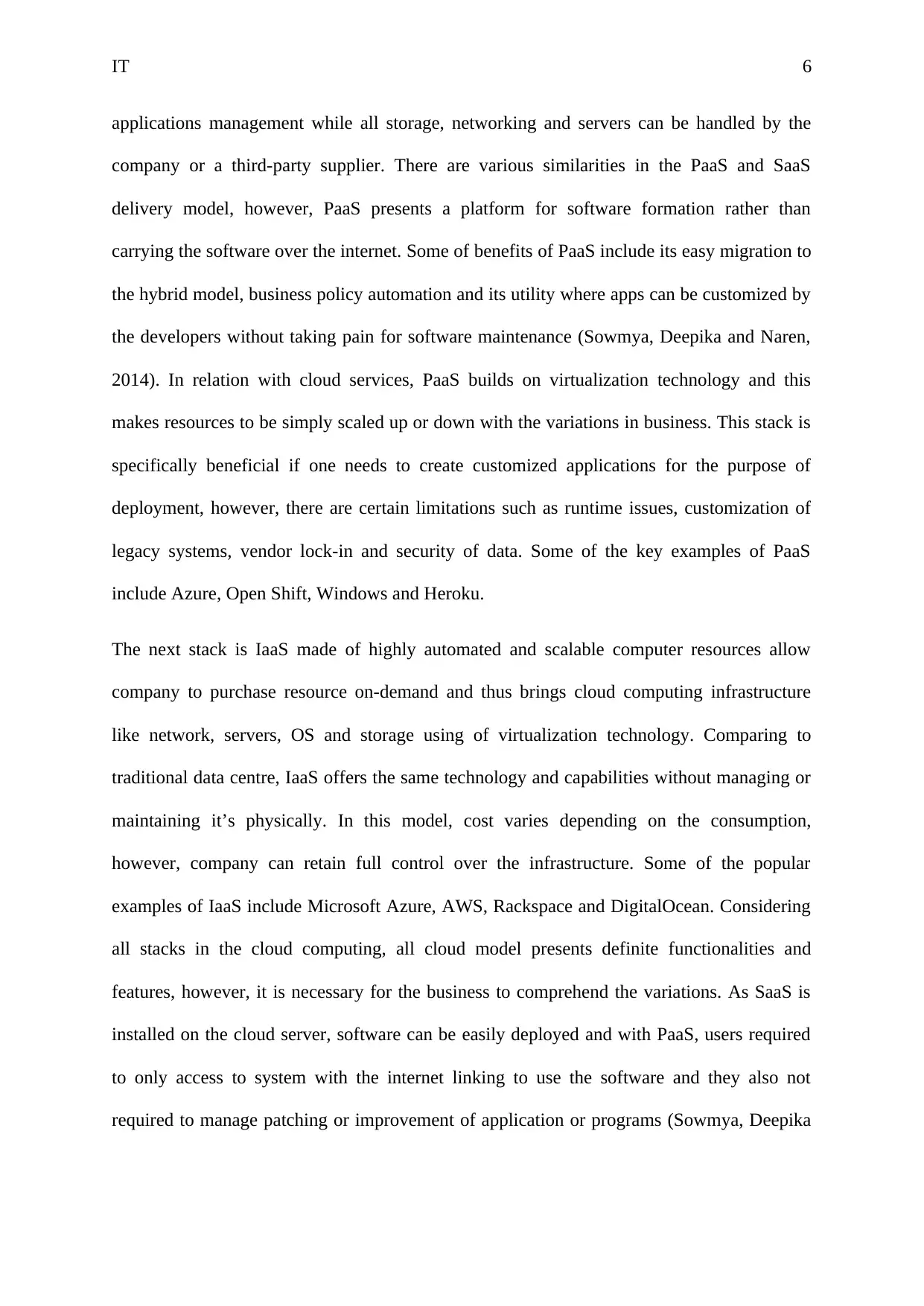
IT 6
applications management while all storage, networking and servers can be handled by the
company or a third-party supplier. There are various similarities in the PaaS and SaaS
delivery model, however, PaaS presents a platform for software formation rather than
carrying the software over the internet. Some of benefits of PaaS include its easy migration to
the hybrid model, business policy automation and its utility where apps can be customized by
the developers without taking pain for software maintenance (Sowmya, Deepika and Naren,
2014). In relation with cloud services, PaaS builds on virtualization technology and this
makes resources to be simply scaled up or down with the variations in business. This stack is
specifically beneficial if one needs to create customized applications for the purpose of
deployment, however, there are certain limitations such as runtime issues, customization of
legacy systems, vendor lock-in and security of data. Some of the key examples of PaaS
include Azure, Open Shift, Windows and Heroku.
The next stack is IaaS made of highly automated and scalable computer resources allow
company to purchase resource on-demand and thus brings cloud computing infrastructure
like network, servers, OS and storage using of virtualization technology. Comparing to
traditional data centre, IaaS offers the same technology and capabilities without managing or
maintaining it’s physically. In this model, cost varies depending on the consumption,
however, company can retain full control over the infrastructure. Some of the popular
examples of IaaS include Microsoft Azure, AWS, Rackspace and DigitalOcean. Considering
all stacks in the cloud computing, all cloud model presents definite functionalities and
features, however, it is necessary for the business to comprehend the variations. As SaaS is
installed on the cloud server, software can be easily deployed and with PaaS, users required
to only access to system with the internet linking to use the software and they also not
required to manage patching or improvement of application or programs (Sowmya, Deepika
applications management while all storage, networking and servers can be handled by the
company or a third-party supplier. There are various similarities in the PaaS and SaaS
delivery model, however, PaaS presents a platform for software formation rather than
carrying the software over the internet. Some of benefits of PaaS include its easy migration to
the hybrid model, business policy automation and its utility where apps can be customized by
the developers without taking pain for software maintenance (Sowmya, Deepika and Naren,
2014). In relation with cloud services, PaaS builds on virtualization technology and this
makes resources to be simply scaled up or down with the variations in business. This stack is
specifically beneficial if one needs to create customized applications for the purpose of
deployment, however, there are certain limitations such as runtime issues, customization of
legacy systems, vendor lock-in and security of data. Some of the key examples of PaaS
include Azure, Open Shift, Windows and Heroku.
The next stack is IaaS made of highly automated and scalable computer resources allow
company to purchase resource on-demand and thus brings cloud computing infrastructure
like network, servers, OS and storage using of virtualization technology. Comparing to
traditional data centre, IaaS offers the same technology and capabilities without managing or
maintaining it’s physically. In this model, cost varies depending on the consumption,
however, company can retain full control over the infrastructure. Some of the popular
examples of IaaS include Microsoft Azure, AWS, Rackspace and DigitalOcean. Considering
all stacks in the cloud computing, all cloud model presents definite functionalities and
features, however, it is necessary for the business to comprehend the variations. As SaaS is
installed on the cloud server, software can be easily deployed and with PaaS, users required
to only access to system with the internet linking to use the software and they also not
required to manage patching or improvement of application or programs (Sowmya, Deepika
Paraphrase This Document
Need a fresh take? Get an instant paraphrase of this document with our AI Paraphraser
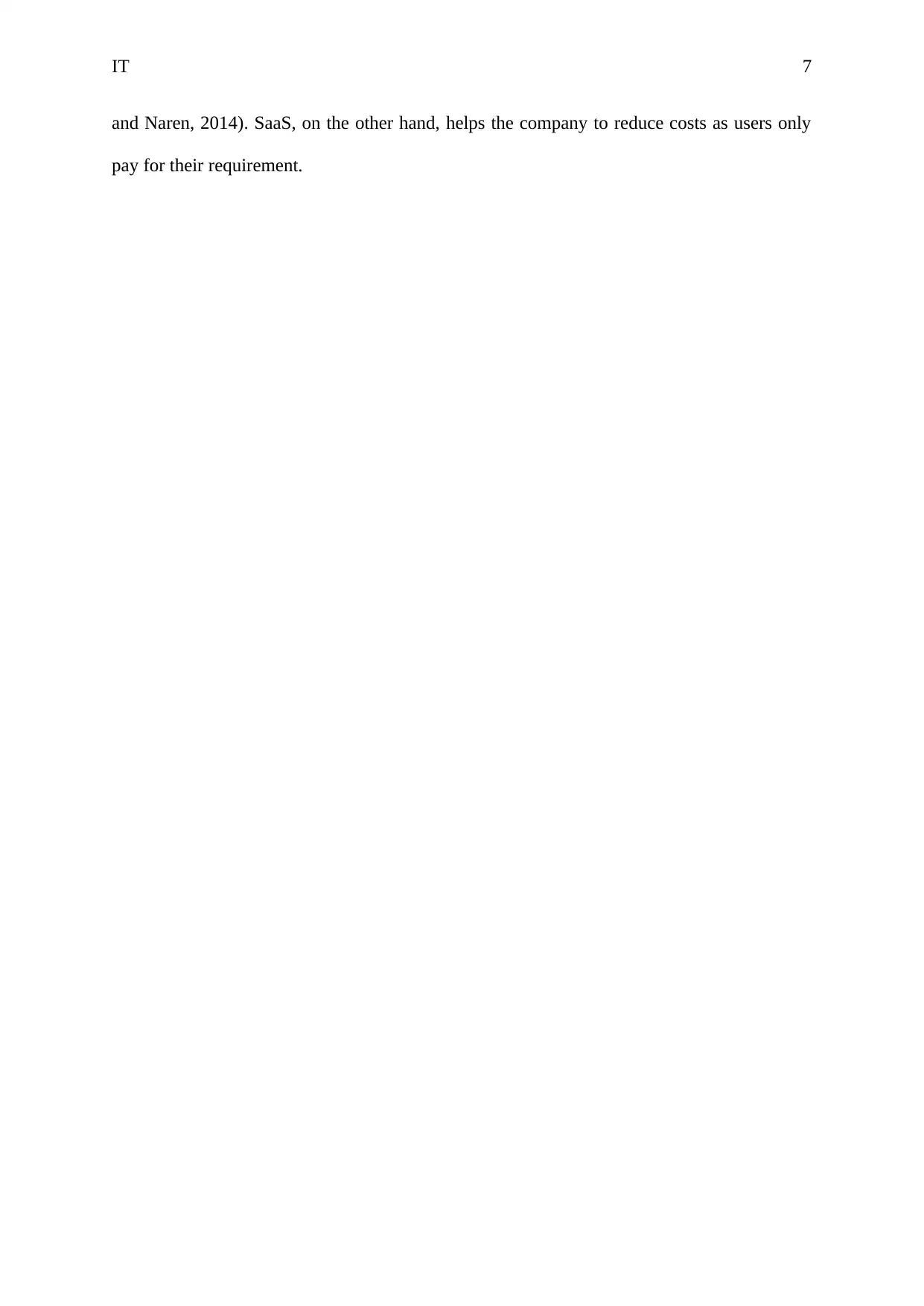
IT 7
and Naren, 2014). SaaS, on the other hand, helps the company to reduce costs as users only
pay for their requirement.
and Naren, 2014). SaaS, on the other hand, helps the company to reduce costs as users only
pay for their requirement.
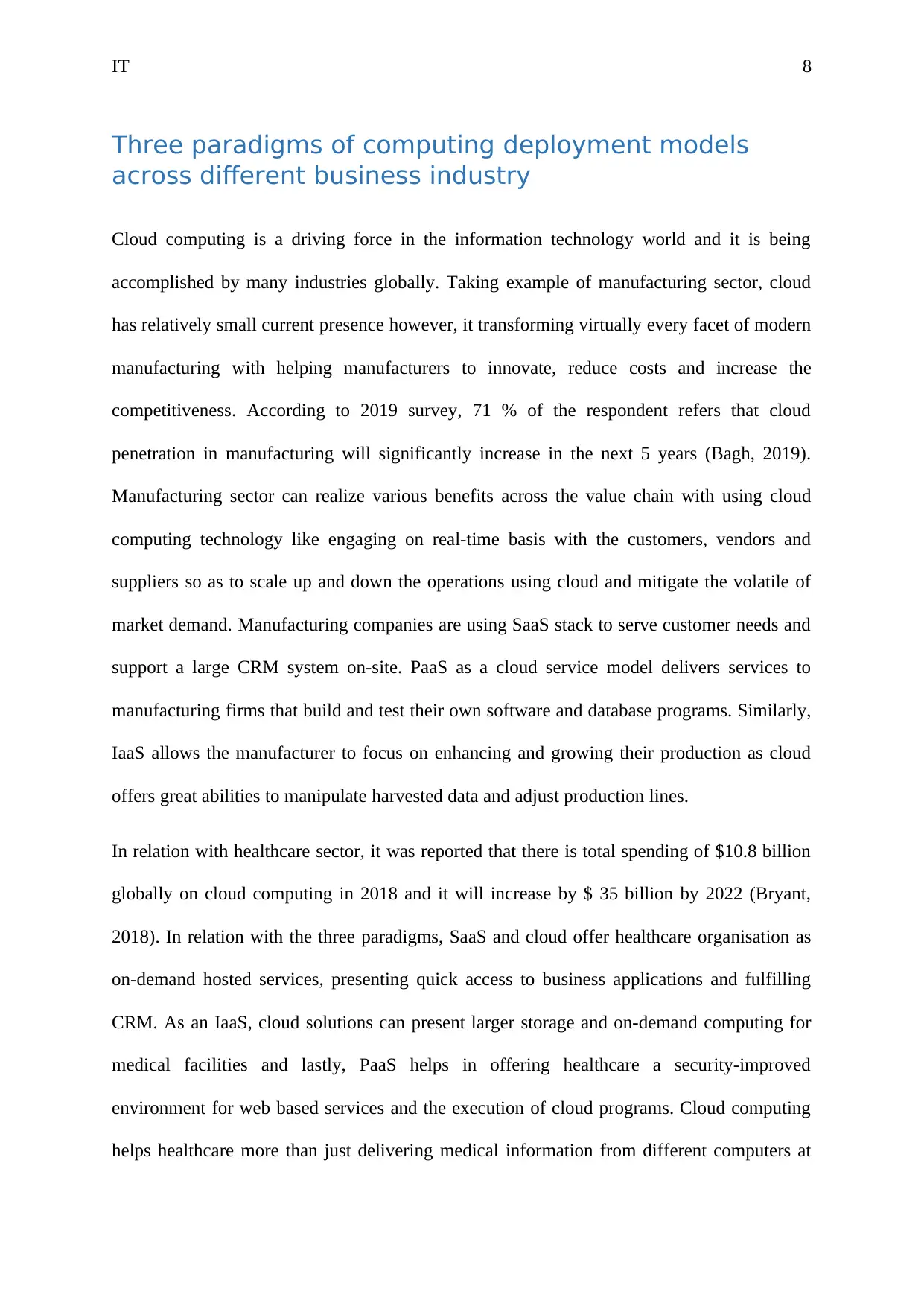
IT 8
Three paradigms of computing deployment models
across different business industry
Cloud computing is a driving force in the information technology world and it is being
accomplished by many industries globally. Taking example of manufacturing sector, cloud
has relatively small current presence however, it transforming virtually every facet of modern
manufacturing with helping manufacturers to innovate, reduce costs and increase the
competitiveness. According to 2019 survey, 71 % of the respondent refers that cloud
penetration in manufacturing will significantly increase in the next 5 years (Bagh, 2019).
Manufacturing sector can realize various benefits across the value chain with using cloud
computing technology like engaging on real-time basis with the customers, vendors and
suppliers so as to scale up and down the operations using cloud and mitigate the volatile of
market demand. Manufacturing companies are using SaaS stack to serve customer needs and
support a large CRM system on-site. PaaS as a cloud service model delivers services to
manufacturing firms that build and test their own software and database programs. Similarly,
IaaS allows the manufacturer to focus on enhancing and growing their production as cloud
offers great abilities to manipulate harvested data and adjust production lines.
In relation with healthcare sector, it was reported that there is total spending of $10.8 billion
globally on cloud computing in 2018 and it will increase by $ 35 billion by 2022 (Bryant,
2018). In relation with the three paradigms, SaaS and cloud offer healthcare organisation as
on-demand hosted services, presenting quick access to business applications and fulfilling
CRM. As an IaaS, cloud solutions can present larger storage and on-demand computing for
medical facilities and lastly, PaaS helps in offering healthcare a security-improved
environment for web based services and the execution of cloud programs. Cloud computing
helps healthcare more than just delivering medical information from different computers at
Three paradigms of computing deployment models
across different business industry
Cloud computing is a driving force in the information technology world and it is being
accomplished by many industries globally. Taking example of manufacturing sector, cloud
has relatively small current presence however, it transforming virtually every facet of modern
manufacturing with helping manufacturers to innovate, reduce costs and increase the
competitiveness. According to 2019 survey, 71 % of the respondent refers that cloud
penetration in manufacturing will significantly increase in the next 5 years (Bagh, 2019).
Manufacturing sector can realize various benefits across the value chain with using cloud
computing technology like engaging on real-time basis with the customers, vendors and
suppliers so as to scale up and down the operations using cloud and mitigate the volatile of
market demand. Manufacturing companies are using SaaS stack to serve customer needs and
support a large CRM system on-site. PaaS as a cloud service model delivers services to
manufacturing firms that build and test their own software and database programs. Similarly,
IaaS allows the manufacturer to focus on enhancing and growing their production as cloud
offers great abilities to manipulate harvested data and adjust production lines.
In relation with healthcare sector, it was reported that there is total spending of $10.8 billion
globally on cloud computing in 2018 and it will increase by $ 35 billion by 2022 (Bryant,
2018). In relation with the three paradigms, SaaS and cloud offer healthcare organisation as
on-demand hosted services, presenting quick access to business applications and fulfilling
CRM. As an IaaS, cloud solutions can present larger storage and on-demand computing for
medical facilities and lastly, PaaS helps in offering healthcare a security-improved
environment for web based services and the execution of cloud programs. Cloud computing
helps healthcare more than just delivering medical information from different computers at
⊘ This is a preview!⊘
Do you want full access?
Subscribe today to unlock all pages.

Trusted by 1+ million students worldwide
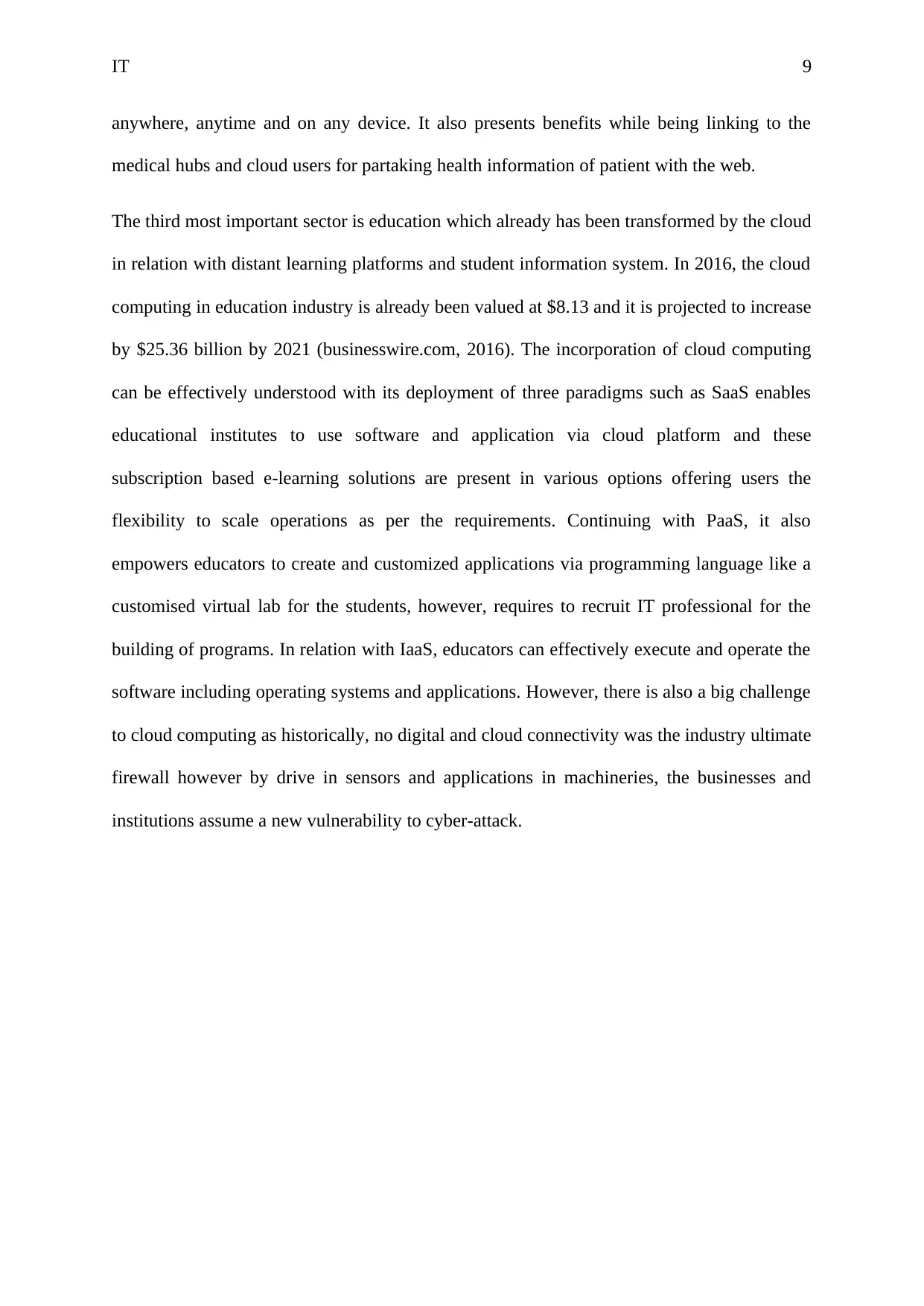
IT 9
anywhere, anytime and on any device. It also presents benefits while being linking to the
medical hubs and cloud users for partaking health information of patient with the web.
The third most important sector is education which already has been transformed by the cloud
in relation with distant learning platforms and student information system. In 2016, the cloud
computing in education industry is already been valued at $8.13 and it is projected to increase
by $25.36 billion by 2021 (businesswire.com, 2016). The incorporation of cloud computing
can be effectively understood with its deployment of three paradigms such as SaaS enables
educational institutes to use software and application via cloud platform and these
subscription based e-learning solutions are present in various options offering users the
flexibility to scale operations as per the requirements. Continuing with PaaS, it also
empowers educators to create and customized applications via programming language like a
customised virtual lab for the students, however, requires to recruit IT professional for the
building of programs. In relation with IaaS, educators can effectively execute and operate the
software including operating systems and applications. However, there is also a big challenge
to cloud computing as historically, no digital and cloud connectivity was the industry ultimate
firewall however by drive in sensors and applications in machineries, the businesses and
institutions assume a new vulnerability to cyber-attack.
anywhere, anytime and on any device. It also presents benefits while being linking to the
medical hubs and cloud users for partaking health information of patient with the web.
The third most important sector is education which already has been transformed by the cloud
in relation with distant learning platforms and student information system. In 2016, the cloud
computing in education industry is already been valued at $8.13 and it is projected to increase
by $25.36 billion by 2021 (businesswire.com, 2016). The incorporation of cloud computing
can be effectively understood with its deployment of three paradigms such as SaaS enables
educational institutes to use software and application via cloud platform and these
subscription based e-learning solutions are present in various options offering users the
flexibility to scale operations as per the requirements. Continuing with PaaS, it also
empowers educators to create and customized applications via programming language like a
customised virtual lab for the students, however, requires to recruit IT professional for the
building of programs. In relation with IaaS, educators can effectively execute and operate the
software including operating systems and applications. However, there is also a big challenge
to cloud computing as historically, no digital and cloud connectivity was the industry ultimate
firewall however by drive in sensors and applications in machineries, the businesses and
institutions assume a new vulnerability to cyber-attack.
Paraphrase This Document
Need a fresh take? Get an instant paraphrase of this document with our AI Paraphraser
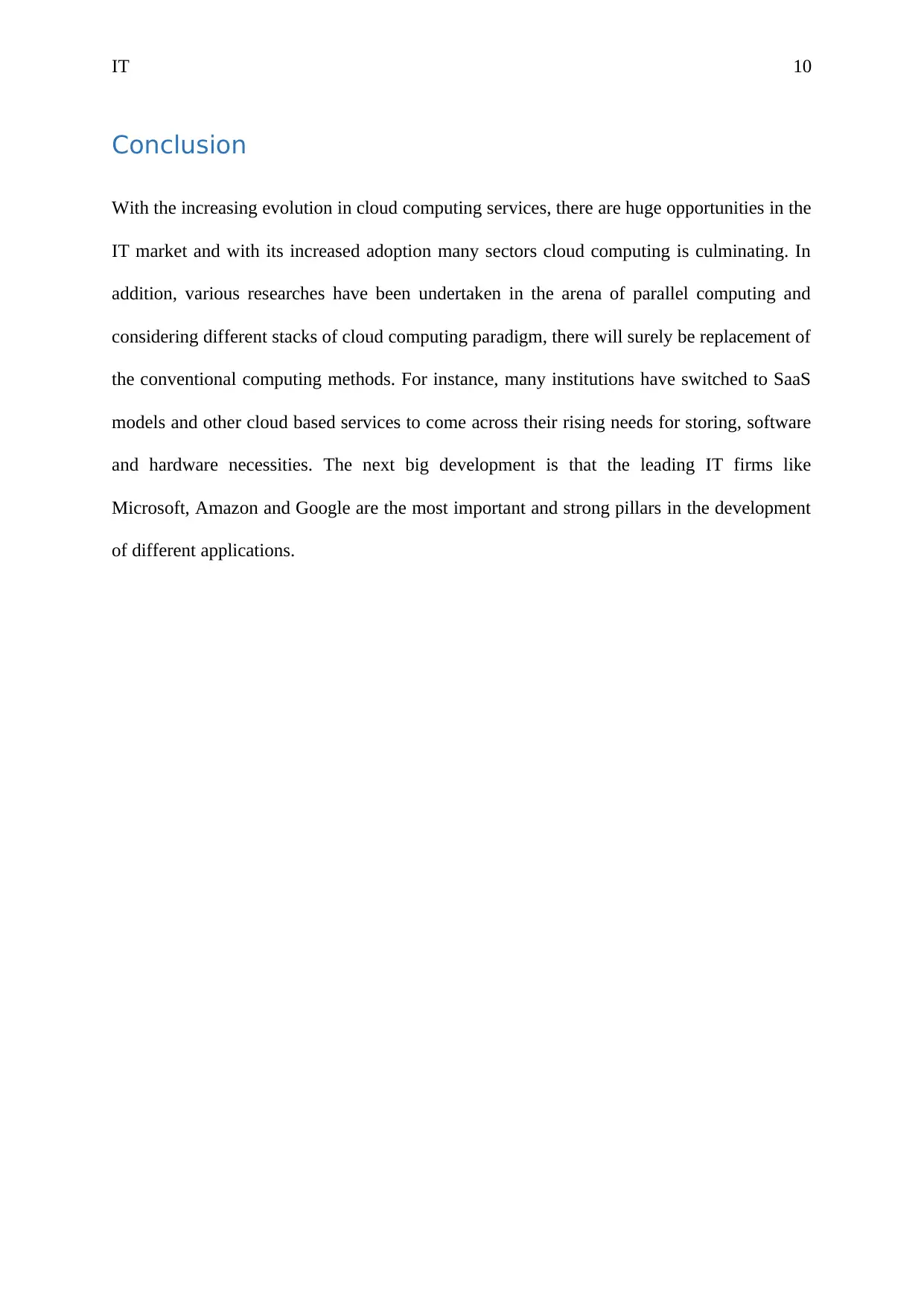
IT 10
Conclusion
With the increasing evolution in cloud computing services, there are huge opportunities in the
IT market and with its increased adoption many sectors cloud computing is culminating. In
addition, various researches have been undertaken in the arena of parallel computing and
considering different stacks of cloud computing paradigm, there will surely be replacement of
the conventional computing methods. For instance, many institutions have switched to SaaS
models and other cloud based services to come across their rising needs for storing, software
and hardware necessities. The next big development is that the leading IT firms like
Microsoft, Amazon and Google are the most important and strong pillars in the development
of different applications.
Conclusion
With the increasing evolution in cloud computing services, there are huge opportunities in the
IT market and with its increased adoption many sectors cloud computing is culminating. In
addition, various researches have been undertaken in the arena of parallel computing and
considering different stacks of cloud computing paradigm, there will surely be replacement of
the conventional computing methods. For instance, many institutions have switched to SaaS
models and other cloud based services to come across their rising needs for storing, software
and hardware necessities. The next big development is that the leading IT firms like
Microsoft, Amazon and Google are the most important and strong pillars in the development
of different applications.
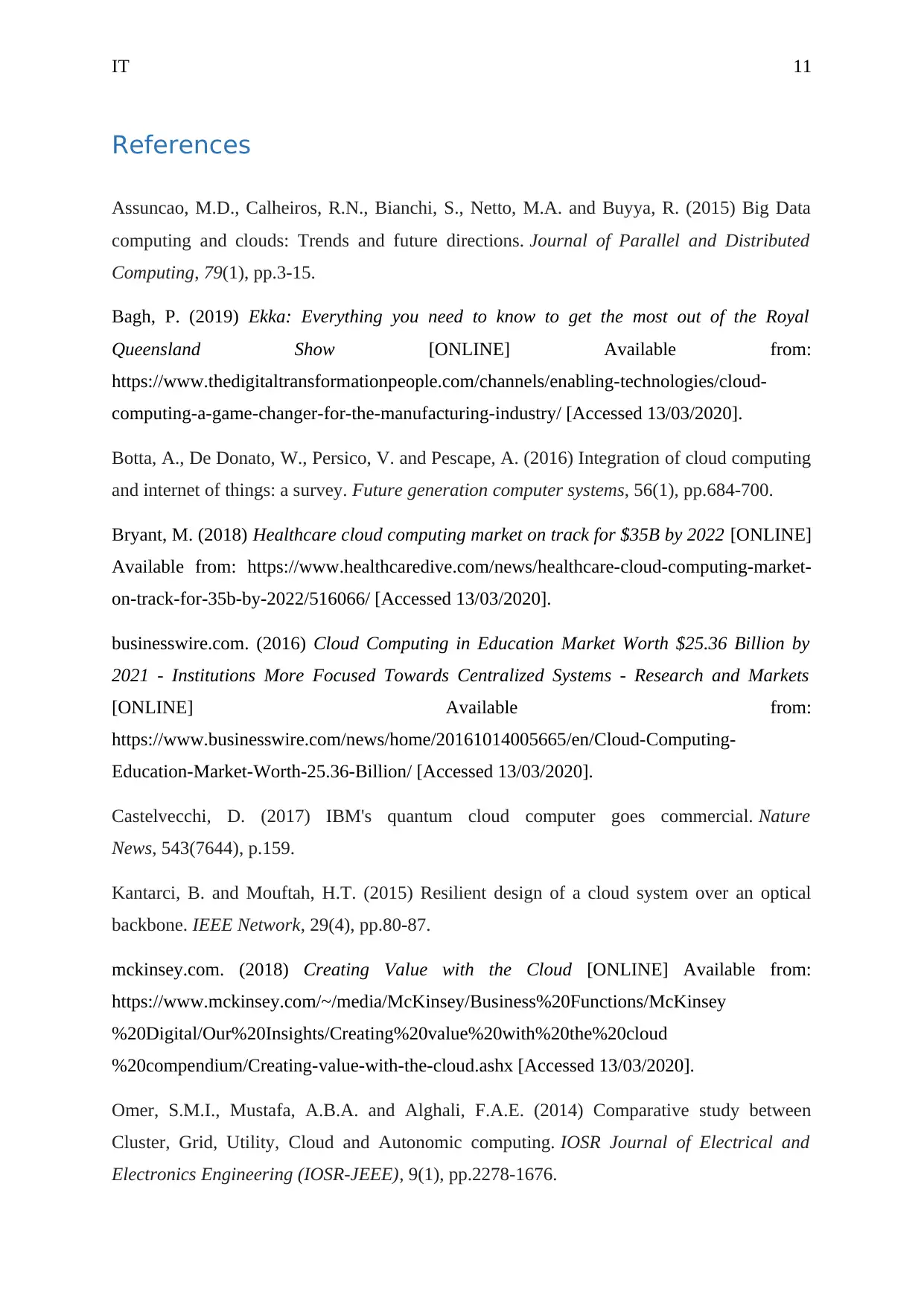
IT 11
References
Assuncao, M.D., Calheiros, R.N., Bianchi, S., Netto, M.A. and Buyya, R. (2015) Big Data
computing and clouds: Trends and future directions. Journal of Parallel and Distributed
Computing, 79(1), pp.3-15.
Bagh, P. (2019) Ekka: Everything you need to know to get the most out of the Royal
Queensland Show [ONLINE] Available from:
https://www.thedigitaltransformationpeople.com/channels/enabling-technologies/cloud-
computing-a-game-changer-for-the-manufacturing-industry/ [Accessed 13/03/2020].
Botta, A., De Donato, W., Persico, V. and Pescape, A. (2016) Integration of cloud computing
and internet of things: a survey. Future generation computer systems, 56(1), pp.684-700.
Bryant, M. (2018) Healthcare cloud computing market on track for $35B by 2022 [ONLINE]
Available from: https://www.healthcaredive.com/news/healthcare-cloud-computing-market-
on-track-for-35b-by-2022/516066/ [Accessed 13/03/2020].
businesswire.com. (2016) Cloud Computing in Education Market Worth $25.36 Billion by
2021 - Institutions More Focused Towards Centralized Systems - Research and Markets
[ONLINE] Available from:
https://www.businesswire.com/news/home/20161014005665/en/Cloud-Computing-
Education-Market-Worth-25.36-Billion/ [Accessed 13/03/2020].
Castelvecchi, D. (2017) IBM's quantum cloud computer goes commercial. Nature
News, 543(7644), p.159.
Kantarci, B. and Mouftah, H.T. (2015) Resilient design of a cloud system over an optical
backbone. IEEE Network, 29(4), pp.80-87.
mckinsey.com. (2018) Creating Value with the Cloud [ONLINE] Available from:
https://www.mckinsey.com/~/media/McKinsey/Business%20Functions/McKinsey
%20Digital/Our%20Insights/Creating%20value%20with%20the%20cloud
%20compendium/Creating-value-with-the-cloud.ashx [Accessed 13/03/2020].
Omer, S.M.I., Mustafa, A.B.A. and Alghali, F.A.E. (2014) Comparative study between
Cluster, Grid, Utility, Cloud and Autonomic computing. IOSR Journal of Electrical and
Electronics Engineering (IOSR-JEEE), 9(1), pp.2278-1676.
References
Assuncao, M.D., Calheiros, R.N., Bianchi, S., Netto, M.A. and Buyya, R. (2015) Big Data
computing and clouds: Trends and future directions. Journal of Parallel and Distributed
Computing, 79(1), pp.3-15.
Bagh, P. (2019) Ekka: Everything you need to know to get the most out of the Royal
Queensland Show [ONLINE] Available from:
https://www.thedigitaltransformationpeople.com/channels/enabling-technologies/cloud-
computing-a-game-changer-for-the-manufacturing-industry/ [Accessed 13/03/2020].
Botta, A., De Donato, W., Persico, V. and Pescape, A. (2016) Integration of cloud computing
and internet of things: a survey. Future generation computer systems, 56(1), pp.684-700.
Bryant, M. (2018) Healthcare cloud computing market on track for $35B by 2022 [ONLINE]
Available from: https://www.healthcaredive.com/news/healthcare-cloud-computing-market-
on-track-for-35b-by-2022/516066/ [Accessed 13/03/2020].
businesswire.com. (2016) Cloud Computing in Education Market Worth $25.36 Billion by
2021 - Institutions More Focused Towards Centralized Systems - Research and Markets
[ONLINE] Available from:
https://www.businesswire.com/news/home/20161014005665/en/Cloud-Computing-
Education-Market-Worth-25.36-Billion/ [Accessed 13/03/2020].
Castelvecchi, D. (2017) IBM's quantum cloud computer goes commercial. Nature
News, 543(7644), p.159.
Kantarci, B. and Mouftah, H.T. (2015) Resilient design of a cloud system over an optical
backbone. IEEE Network, 29(4), pp.80-87.
mckinsey.com. (2018) Creating Value with the Cloud [ONLINE] Available from:
https://www.mckinsey.com/~/media/McKinsey/Business%20Functions/McKinsey
%20Digital/Our%20Insights/Creating%20value%20with%20the%20cloud
%20compendium/Creating-value-with-the-cloud.ashx [Accessed 13/03/2020].
Omer, S.M.I., Mustafa, A.B.A. and Alghali, F.A.E. (2014) Comparative study between
Cluster, Grid, Utility, Cloud and Autonomic computing. IOSR Journal of Electrical and
Electronics Engineering (IOSR-JEEE), 9(1), pp.2278-1676.
⊘ This is a preview!⊘
Do you want full access?
Subscribe today to unlock all pages.

Trusted by 1+ million students worldwide
1 out of 13
Related Documents
Your All-in-One AI-Powered Toolkit for Academic Success.
+13062052269
info@desklib.com
Available 24*7 on WhatsApp / Email
![[object Object]](/_next/static/media/star-bottom.7253800d.svg)
Unlock your academic potential
Copyright © 2020–2025 A2Z Services. All Rights Reserved. Developed and managed by ZUCOL.



